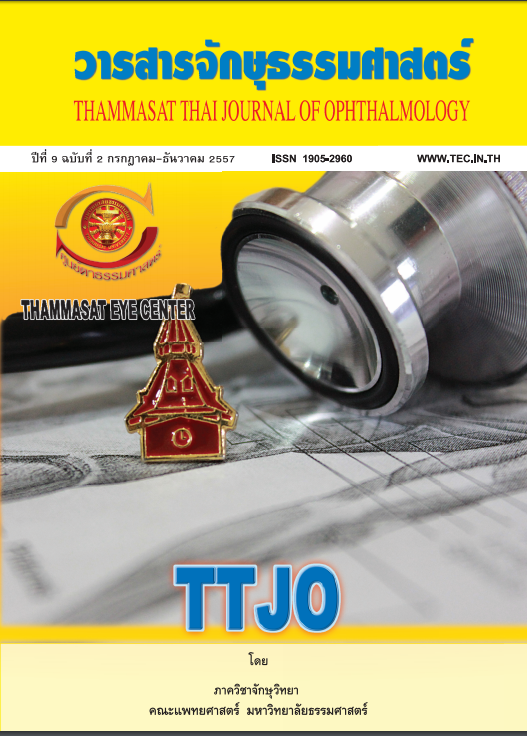การศึกษาเปรียบเทียบภาพถ่ายจอตาบริเวณเดียวกับการตรวจมาตรฐาน ด้วยเลนส์กำลังขยายสูงในการคัดกรองเบาหวานเข้าจอตา
Main Article Content
Abstract
วัตถุประสงค์: เพื่อศึกษาคุณสมบัติเชิงวินิจฉัยของ ภาพถ่ายจอตาบริเวณเดียวเปรียบเทียบกับการตรวจ มาตรฐานในการคัดกรองโรคเบาหวานเข้าจอตา
รูปแบบการศึกษา: การวิจัยเชิงวินิจฉัยด้วยรูปแบบ cross-sectional
วิธีการศึกษา: ค้นหาผู้ป่วยที่มาตรวจที่คลินิกเบาหวาน เข้าจอตาและคลินิกจอตา ณ หน่วยตรวจตาโรงพยาบาล ธรรมศาสตร์เฉลิมพระเกียรติ ตั้งแต่ มิถุนายน 2555 ถึง ธันวาคม 2556 โดยผู้ป่วยจะได้รับการถ่ายรูปจอตา ด้วยกล้องถ่ายภาพจอตาแบบไม่ขยายม่านตา (non-mydriatic fundus camera) และทำการตรวจจอตาโดย จักษุแพทย์จอตา ศึกษาเปรียบเทียบระหว่างภาพถ่าย จอตาบริเวณเดียวที่อ่านโดยจักษุแพทย์ที่ชำนาญในการ อ่านภาพถ่ายจอตากับการตรวจจอตาด้วยวิธีมาตรฐาน โดยจักษุแพทย์จอตา
ผลการศึกษา: ภาพถ่ายทั้งหมด 267 รูป มีภาพถ่ายที่ สามารถแปลผลได้จำนวน 239 รูป การใช้ภาพถ่าย
จอตาบริเวณเดียวเพื่อวินิจฉัยผู้ป่วยเบาหวานเข้าจอตา พบว่ามีค่าความไวเท่ากับ 81.8% (95% CI 74.6-87.6) และ ความจำเพาะ 98.9% (95% CI 94.0-100.0) โดยมี ค่าการทำนายผลบวก 99.2% (95% CI 99.5-100.0) และค่าการทำนายผลลบ 76.9% (95% CI 68.2-84.2) การวินิจฉัยผู้ป่วยเบาหวานเข้าจอตาชนิดพบเส้นเลือดงอก(proliferative diabetic retinopathy) มีค่าความไว เท่ากับ 64.2% (95% CI 52.8-74.6) และความจำเพาะ 98.7% (95% CI 95.5-98.8) ค่าการทำนายผลบวก 96.3% (95% CI 87.3-99.5) และค่าการทำนายผลลบ 84.3% (95% CI 78.3-89.2)
สรุป: ภาพถ่ายจอตาบริเวณเดียวสามารถคัดกรองเบา หวานเข้าจอตาได้ เป็นวิธีที่ง่าย สะดวก รวดเร็ว ในการ คัดกรองผู้ป่วยเบาหวานเข้าจอตา แต่ไม่สามารถใช้แทน การตรวจมาตรฐานได้ เพราะไม่สามารถใช้แยกกลุ่ม ผู้ป่วยเบาหวานขึ้นจอตาชนิดพบเส้นเลือดงอกได้ดีพอ
Comparison between High Resolution Single-field Digital
Fundus Photography and Gold Standard Microscopic Lens for
Diabetic Retinopathy Screening
Objective: To evaluate the agreement between using the single-field digital fundus camera compared with gold standard microscopic lens for diabetic retinopathy (DR) screening.
Design: Diagnostic study.
Methods: This is a prospective study receiving data from DR screening in diabetic patient at diabetic retinopathy clinic and retina clinic, Thammasat University hospital from June 2012 to December 2013. In all case, the diagnosis was made by biomicroscopic lens as a gold standard compared with the fundus photograph classified by experienced ophthalmologist.
Results: There were 239 eyes from 267 eyes that have good quality picture included in this study. The sensitivity and specificity for DR screening were 81.8%
(95% CI 74.6-87.6) and 98.9% (95% CI 94.0-100.0) respectively. The positive predictive value and negative predictive value were 99.2% (95% CI 99.5-100.0) and 76.9% (95% CI 68.2-84.2) respectively. The sensitivity and specificity for proliferative diabetic retinopathy screening were 64.2% (95%CI 52.8-74.6) and 98.7% (95%CI 95.5-98.8) respectively. The positive predictive value and negative predictive value were 96.3% (95%CI 87.3-99.5) and 84.3% (95%CI 78.3-89.2) respectively.
Conclusion: Digital fundus camera is a method for DR screening. It is easy, convenient and fast method. But it is not ideal as a standard examination due to low correlation in proliferative diabetic retinopathy cases that should be treated with laser photocoagulation.


